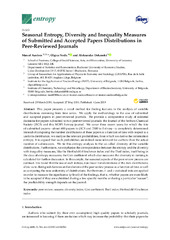Приказ основних података о документу
Seasonal Entropy, Diversity and Inequality Measures of Submitted and Accepted Papers Distributions in Peer-Reviewed Journals
| dc.creator | Ausloos, Marcel | |
| dc.creator | Nedić, Olgica | |
| dc.creator | Dekanski, Aleksandar | |
| dc.date.accessioned | 2019-07-17T10:11:39Z | |
| dc.date.available | 2019-07-17T10:11:39Z | |
| dc.date.issued | 2019 | |
| dc.identifier.issn | 1099-4300 | |
| dc.identifier.uri | https://cer.ihtm.bg.ac.rs/handle/123456789/3038 | |
| dc.description.abstract | This paper presents a novel method for finding features in the analysis of variable distributions stemming from time series. We apply the methodology to the case of submitted and accepted papers in peer-reviewed journals. We provide a comparative study of editorial decisions for papers submitted to two peer-reviewed journals: the Journal of the Serbian Chemical Society (JSCS) and this MDPI Entropy journal. We cover three recent years for which the fate of submitted papers-about 600 papers to JSCS and 2500 to Entropy-is completely determined. Instead of comparing the number distributions of these papers as a function of time with respect to a uniform distribution, we analyze the relevant probabilities, from which we derive the information entropy. It is argued that such probabilities are indeed more relevant for authors than the actual number of submissions. We tie this entropy analysis to the so called diversity of the variable distributions. Furthermore, we emphasize the correspondence between the entropy and the diversity with inequality measures, like the Herfindahl-Hirschman index and the Theil index, itself being in the class of entropy measures; the Gini coefficient which also measures the diversity in ranking is calculated for further discussion. In this sample, the seasonal aspects of the peer review process are outlined. It is found that the use of such indices, non linear transformations of the data distributions, allow us to distinguish features and evolutions of the peer review process as a function of time as well as comparing the non-uniformity of distributions. Furthermore, t- and z-statistical tests are applied in order to measure the significance (p-level) of the findings, that is, whether papers are more likely to be accepted if they are submitted during a few specific months or during a particular "season"; the predictability strength depends on the journal. | en |
| dc.language.iso | en | sr |
| dc.publisher | MDPI | sr |
| dc.rights | openAccess | sr |
| dc.rights.uri | https://creativecommons.org/licenses/by/4.0/ | |
| dc.source | Entropy | |
| dc.subject | peer review | sr |
| dc.subject | seasons | sr |
| dc.subject | diversity index | sr |
| dc.subject | Gini coefficient | sr |
| dc.subject | Theil index | sr |
| dc.subject | Herfindahl-Hirschman index | sr |
| dc.title | Seasonal Entropy, Diversity and Inequality Measures of Submitted and Accepted Papers Distributions in Peer-Reviewed Journals | en |
| dc.type | article | sr |
| dc.rights.license | BY | sr |
| dcterms.abstract | Aуслоос, Марцел; Декански, Aлександар; Недић, Олгица; | |
| dc.rights.holder | Authors | sr |
| dc.citation.volume | 21 | |
| dc.citation.issue | 6 | |
| dc.citation.spage | 564 | |
| dc.citation.rank | M21~ | |
| dc.identifier.doi | 10.3390/e21060564 | |
| dc.identifier.fulltext | https://cer.ihtm.bg.ac.rs//bitstream/id/7536/entropy-21-00564-v2.pdf | |
| dc.identifier.scopus | 2-s2.0-85068038464 | |
| dc.identifier.wos | 000475304200025 | |
| dc.type.version | publishedVersion | sr |


